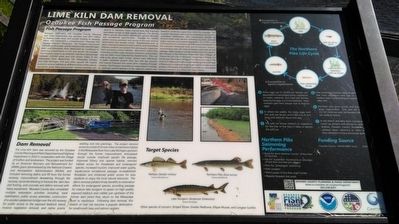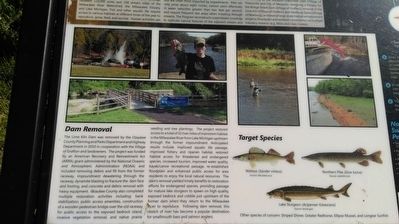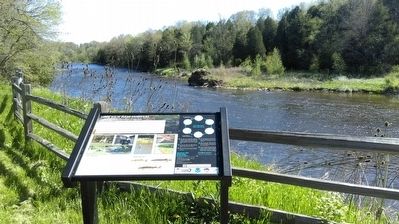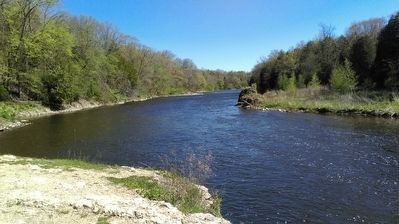Grafton in Ozaukee County, Wisconsin — The American Midwest (Great Lakes)
Lime Kiln Dam Removal
Ozaukee Fish Passage Program
Between 2006-2013, the Ozaukee County Planning and Parks Department was awarded over $8.5 million in federal, state, local, and private funding to develop, refine, and implement a comprehensive "Ozaukee Fish Passage Program" (Program). The Program reconnects naturally existing high-quality habitat in the Lake Michigan Basin and Milwaukee River Watershed by modifying or removing impediments to fish and aquatic life passage. The Program seeks to re-establish migratory fish passage between 119,000 acres and 158 stream miles of the Milwaukee River Watershed, the Milwaukee Estuary, and Lake Michigan. Fish and other aquatic life require access to various habitats at different times of the year to reproduce, grow, feed, and survive. Human activities can directly or indirectly create impediments that fragment and inhibit access to high quality habitats. This directly affects species abundance, distribution, genetic diversity, and recreational opportunities. Passage for healthy adults moving upstream and young-of-the-year moving downstream are equally crucial. Impediments such as dams, improperly placed or sized culverts, and channelized tributary streams can prevent fish and aquatic organisms from accessing critical habitats. Wisconsin's native fish, including northern pike, are poor swimmers and jumpers and are often most impacted by impediments. Pike can only jump about eight inches, cannot swim effectively in water velocities greater than two feet per second, and require frequent rest areas when traveling through streams. The Program reconstructs road/stream crossings to replicate natural features of the adjacent stream and establish conditions supporting native fish passage. The Program also works with local municipalities, non-profits, volunteers, landowners, and conservation groups to remove small-scale barriers including log jams, railroad ballast deposits, and invasive vegetation. As of 2013, over 203 impediments have been identified and remediated on the mainstem Milwaukee River and 30 tributary streams, reconnecting over 100 miles of streams and rivers to fish passage. Major projects include construction of a nature-like fishway at the Mequon-Thiensville Dam (Village of Thiensville and City of Mequon), designing a fishway for the Bridge Street Dam (Village of Grafton), removal of the Lime Kiln (Village of Grafton) and Newburg Dams (Village of Newburg), and several large-scale habitat enhancement projects (floodplain and wetland connectivity) on multiple tributary streams (e.g. Mole and Ulao Creeks).
Dam Removal The Lime Kiln Dam was removed by the Ozaukee County Planning and Parks Department and Highway Department in 2010 in cooperation with the Village of Grafton and landowners. The project was funded by an American Recovery and Reinvestment Act (ARRA) grant administered by the National Oceanic and Atmospheric Administration (NOAA) and included removing debris and fill from the former raceway, impoundment dewatering through the raceway, dynamite blasting to fracture the dam face and footing, and concrete and debris removal with heavy equipment. Ozaukee County also completed multiple restoration activities including: bank stabilization, public access amenities, construction of a wooden pedestrian bridge over the old raceway for public access to the exposed bedrock island, invasive vegetation removal, and native prairie seeding and tree plantings. The project restored access to a total of 32 river miles of mainstream habitat in the Milwaukee River from Lake Michigan upstream through the former impoundment. Anticipated results include: improved aquatic life passage, improved fishery and riparian habitat, restored habitat access for threatened and endangered species, increased tourism, improved water quality, kayak/canoe recreational passage, re-established floodplain and enhanced public access for area residents to enjoy the local natural resources. The dam's removal yielded timely benefits to restoration efforts for endangered species, providing passage for mature lake sturgeon to spawn on high quality, exposed bedrock and cobble just upstream of the former dam when they return to the Milwaukee River to reproduce. Following dam removal, this stretch of river has become a popular destination for smallmouth bass and salmon anglers.
Target Species
Walleye (Sander vitreus)
Northern Pike (Esox lucius)
Lake Sturgeon (Acipenser fulvescens)
Other species of concern: Striped Shiner, Greater Redhorse, Ellipse Mussel, and Longear Sunfish
The Northern Pike Life Cycle A: Sticky eggs (up to 30,000 per female) are deposited on submerged grassy vegetation in creeks, wetlands, and road-side ditches keeping the eggs out of the sediment. Male northern pike then release milt to fertilize eggs.
B: In about two weeks, the sticky eggs turn into yolk sac larvae, which are only 8 mm long and swim for about one day.
C: The yolk sac larvae reattach to vegetation for the four or five days it takes to absorb the yolk sac.
D: Free-swimming northern pike larvae break free from vegetation and stay in warm shallow water, soon feeding on insects and other fish.
E: Northern pike grow quickly and move to larger waterbodies. One year old males (12-16") and two year old females (18-20") are ready to spawn.
F: In late March and early April, mature adults travel up streams and ditches to spawn in shallow, flooded marshy floodplain and wetland areas, returning to areas where they were born or have previously spawned.
Northern Pike Swimming Performance
-Good for short distance "bursts" of less than 15 seconds
-Fair for "sustained" movements in velocities of less than two feet per second
-Poor for "prolonged" swimming
-Poor jumpers
-Short jumps of less than eight inches
-Require frequent rest areas
Funding Source
Ozaukee County - NOAA/ARRA Grant $209,000
Topics. This historical marker is listed in these topic lists: Animals • Waterways & Vessels.
Location. 43° 18.315′ N, 87° 57.215′ W. Marker is in Grafton, Wisconsin, in Ozaukee County. Marker can be reached from Green Bay Road. Touch for map. Marker is in this post office area: Grafton WI 53024, United States of America. Touch for directions.
Other nearby markers. At least 8 other markers are within 2 miles of this marker, measured as the crow flies. Lime Kiln Dam (a few steps from this marker); Grafton Lime Kilns (about 500 feet away, measured in a direct line); Chair Factory History (approx. 0.3 miles away); The Blues Trail: Paramount Records (approx. 0.3 miles away); Paramount Records Legacy (approx. 0.9 miles away); Welcome to the Grafton Riverwalk (approx. 1.1 miles away); Concordia Mill (approx. 1.7 miles away); Origin of Cedar Creek / Mills on the Creek (approx. 1.7 miles away). Touch for a list and map of all markers in Grafton.
More about this marker. Marker is located in Lime Kiln Park near the site of the former dam
Credits. This page was last revised on May 1, 2020. It was originally submitted on June 13, 2016, by Devon Polzar of Port Washington, Wisconsin. This page has been viewed 635 times since then and 54 times this year. Last updated on April 30, 2020, by Devon Polzar of Port Washington, Wisconsin. Photos: 1, 2, 3, 4. submitted on June 13, 2016, by Devon Polzar of Port Washington, Wisconsin. • Mark Hilton was the editor who published this page.



